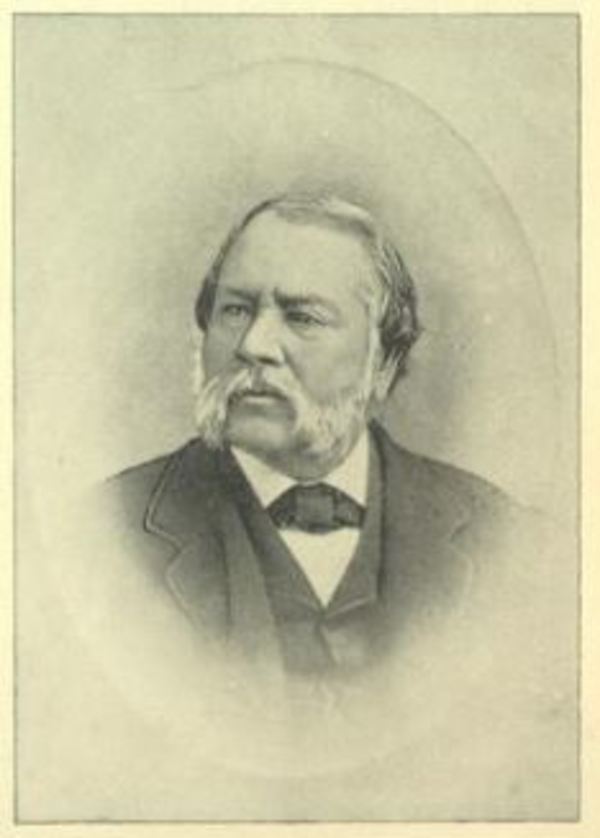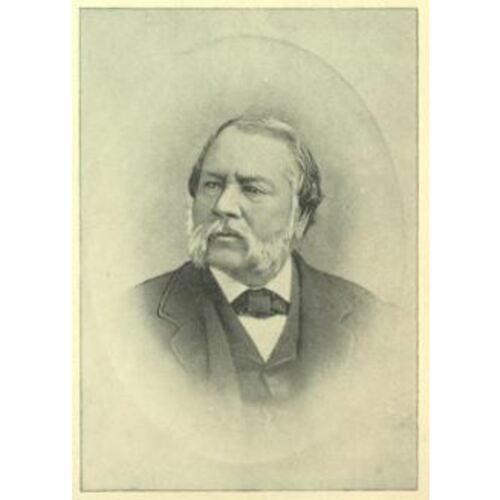
Source: Link
RASTRICK, FREDERICK JAMES, architect, civil engineer, and land agent; baptized 29 Aug. 1819 in West Bromwich, England, third son of John Urpeth Rastrick and Sarah —; m. 21 July 1857 Anna Mary Stephens in Hamilton, Upper Canada, and they had six sons and one daughter; d. there 12 Sept. 1897.
By any standards, Frederick James Rastrick’s training for his profession was impressive. After attending schools in Yorkshire and London, at about 17 he went to work for his father, a leading railway engineer. Then, in 1839, he began a five-year apprenticeship with the eminent architect Charles Barry. When Rastrick’s apprenticeship ended, he enrolled as a student of the Royal Academy of Arts before leaving England for four years to study and sketch in Europe, Asia Minor, and Egypt.
Returning home in 1848, he began practising in London, where, a few years later, he formed a brief partnership with Charles Ainslie. Then in 1852 Rastrick emigrated to Brantford, Upper Canada, giving up a promising English career. Some months later he established a second office in nearby Hamilton, where he settled at the end of 1853. That city’s close-knit mercantile community soon gave him a large part of its patronage. Better trained than other local architects, he had the advantage of home ground over Torontonians such as William Thomas* or Frederic William Cumberland* who until then had enjoyed the lion’s share of important commissions in Hamilton.
Among the first jobs Rastrick undertook was a handsome stone warehouse in classical style built at MacNab and Merrick streets for Young, Law and Company in 1854. Two years later he was retained by John Young*’s brother-in-law, James McIntyre, to design a matching building and by the Bank of Upper Canada to provide plans modelled on an Italian palazzo for a banking house at James and Vine streets. In a less restrained Italianate style was the office building erected on James Street in 1855–56 by the Canada Life Assurance Company to designs by Rastrick, who made considerable use of cast iron in its façade. He may also have been the architect for Richard Juson’s substantial stone warehouse on James Street begun in 1853, for alterations to Sir Allan Napier MacNab*’s Dundurn Castle in 1854–55, and for Sandyford Place built in 1856–57 by Donald Nicholson. Rastrick served as engineer for Wentworth County from 1854 to 1858.
Hamilton’s growing importance during the 1850s was reflected in the decision in 1855 to construct a custom-house there. MacNab, then co-premier of the province, retained Rastrick to design the structure. By the time the drawings had been completed and costed, however, MacNab had resigned. The original proposal was subsequently judged too expensive and in July 1857 the architect was asked to prepare plans for a smaller building. These were put out for tender in April 1858 but, at the urging of Isaac Buchanan*, the member of the assembly for Hamilton, they were abandoned almost immediately as too modest. Five weeks later approval was given to a larger proposal, by Frederick Preston Rubidge of the Department of Public Works, who likely drew heavily on Rastrick’s original designs.
The loss of this job followed two other set-backs to Rastrick’s career, which never regained the same momentum. The first was his failure to gain the position of architect to the Department of Public Works. Encouraged by the department’s assistant commissioner, Hamilton Hartley Killaly*, to believe that the appointment would be forthcoming, Rastrick moved to Toronto early in 1857, where he waited in vain for five months. The second blow was the economic depression that began in September 1857. Late the previous year, when Rastrick expected both the Public Works appointment and the custom-house commission, he had formed a partnership with William Hall and Daniel Berkely Wily. As the depression took hold, however, they found very little work. Among their few projects were a house for John Brown (Highfield on Bay Street) in 1858 and additions to Oakbank on James Street for William Paterson McLaren* the following year. By July 1860 the partners had gone their separate ways.
For much of the following decade Rastrick eked out a living, mostly as a “Land, House and Commission agent.” Although he was retained on occasion to inspect public buildings for repairs, he failed in several renewed efforts to join the Department of Public Works and in a bid in May 1865 to be appointed supervising architect for the completion of the Parliament Buildings in Ottawa. A “positive dearth of employment” in 1867 forced him to offer for sale a large part of his exceptional library of architectural books. The following year he found it necessary to spend at least part of his time practising in Montreal.
In 1870 ill health forced Rastrick to return to Hamilton. There he remained for the rest of his life, enduring several long periods of sickness that interrupted his work, which was mostly routine residential commissions. In 1879 his sons Edward Lewellyn and John Urpeth joined him to form F. J. Rastrick and Sons. Urpeth drowned in a boating accident two years later, but Frederick and Edward practised together, except for three years in the late 1880s, until the senior Rastrick’s death in 1897. The following year a third son, Francis Reginald, became a partner in the firm, which was active until about 1923, when fire destroyed its office and likely most of Frederick Rastrick’s surviving drawings and records.
Tenacity had marked Rastrick’s character, whether he was trying, as he did for 15 years, to collect the balance of the fee that he insisted was owed on the custom-house designs or whether he was attempting to create a professional organization among architects. At least three such associations anticipated the establishment of the permanent bodies that were founded in Ontario and Quebec in the late 1880s. Rastrick was a vice-president of the Association of Architects, Civil Engineers and Provincial Land Surveyors of the Province of Canada in 1860–61 and of its fleeting successor in 1862, the Association of Surveyors, Civil Engineers and Architects. Fourteen years later he was the first president of the short-lived Canadian Institute of Architects. Following the founding of the Ontario Association of Architects in 1889 and its incorporation a year later, Rastrick was appointed by Lieutenant Governor Sir Alexander Campbell to its inaugural council.
A gregarious man, Rastrick was active also in the mechanics’ institute, the masonic lodge, the Sons of England, and the St George’s Society. He was elected an associate of the Royal Canadian Academy of Arts in 1880–81.
A comprehensive list of the buildings designed by Frederick James Rastrick, prepared by Stephen A. Otto, is available in the files of the DCB.
Canada Life Assurance Company Arch. (Toronto), Corporate records. HPL, United Counties of Wentworth and Halton, council minutes, 13 Dec. 1854. NA, RG 11, A1, 25, no.29098; 29, nos.33898, 34225, 34270, 34884; 32, no.37319; A3, 139, no.1765; B1(a), 372: 373–75; 374: 339–41; B1(b), 639, nos.55350, 63617, 75097, 84154. West Bromwich Central Library (West Bromwich, Eng.), All Saints’ Church (West Bromwich), reg. of baptisms, marriages, and burials. “Association of Architects, Civil Engineers and P.L. Surveyors of the Province of Canada,” U.C., Board of Arts and Manufactures, Journal (Toronto), 1 (1861): 14. Builder (London), 20 (1862): 573. British Colonist (Toronto), 20 July 1852, 7 April 1858. Gazette (Montreal), 7 Dec. 1868. Globe, 29 Sept. 1858. Hamilton Spectator, 5 Nov. 1852; 2 Jan., 16 Feb. 1854; 1 April, 9 July, 13 Dec. 1856; 22 July 1857; 5, 26 April, 17, 27 May 1858; 23 May 1859; 3 Aug. 1866; 1 Jan. 1870; 3 March 1879. Mail (Toronto), 29 Dec. 1876. Montreal Herald, 2 March 1870. Canadian album (Cochrane and Hopkins), 1: 253. DHB.
Cite This Article
Stephen A. Otto, “RASTRICK, FREDERICK JAMES,” in Dictionary of Canadian Biography, vol. 12, University of Toronto/Université Laval, 2003–, accessed April 29, 2025, https://www.biographi.ca/en/bio/rastrick_frederick_james_12E.html.
The citation above shows the format for footnotes and endnotes according to the Chicago manual of style (16th edition). Information to be used in other citation formats:
| Permalink: | https://www.biographi.ca/en/bio/rastrick_frederick_james_12E.html |
| Author of Article: | Stephen A. Otto |
| Title of Article: | RASTRICK, FREDERICK JAMES |
| Publication Name: | Dictionary of Canadian Biography, vol. 12 |
| Publisher: | University of Toronto/Université Laval |
| Year of revision: | 1990 |
| Access Date: | April 29, 2025 |



